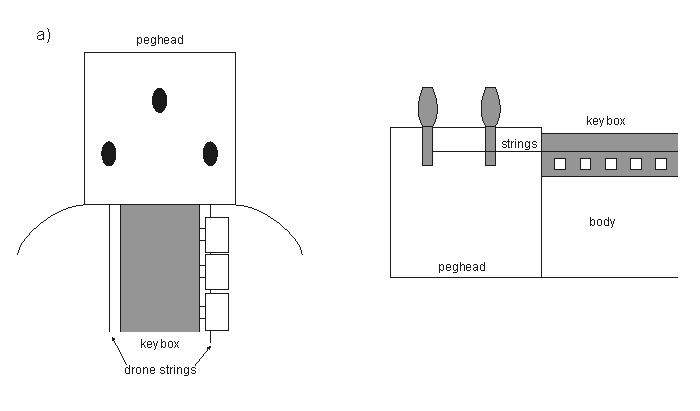
This part of the website is an English translation of the definitive hurdy-gurdy reference book Die Drehleier (The Hurdy-gurdy), written by Marianne Bröcker. For general information about this translation please see the Index Page.
This material is covered by copyright and may not be used without permission. Please see the Index Page for more information about distribution.
| Table of contents | Previous chapter | Next chapter | References | Figures |
A. The Guitar or Figure-Eight Form and its Variations
In addition to the pictorial representations which for the Middle Ages are our only source of information concerning the various shapes of the hurdy-gurdy, from the 16th century onwards we have the first preserved instruments. In general these confirm the correctness of the earlier representations. Various late medieval forms of hurdy-gurdies continued to be built without any drastic changes. Even in the following centuries neither a uniform stringing or number of keys came into being, nor a universally accepted form of body on account of the very different social status of the instrument in various regions, which was suited to the demands of the milieu.
The most important form of the hurdy-gurdy, because it is the oldest and most widely spread, is the guitar or figure-eight form, which the first preserved representations of large Spanish and French hurdy-gurdies show (ills. 13, 14) [figlink], and which until recent times was built in almost all of the countries which were acquainted with the hurdy-gurdy. As the medieval representations show, until the 15th century guitar shaped hurdy-gurdies were provided with a neck, but were not thereby limited to one specific key mechanism: In the Middle Ages keyless hurdy-gurdies (ills. 3, 5) [figlink] as well as instruments with rotating keys (ill. 2) [figlink], push keys (ills. 24, 25) [figlink], pull keys (ills. 13, 14) [figlink], and sliding keys (ills. 46-50, 53) [figlink] were built in this form. A neck could first be discarded when in the 15th century the keybox situated on the soundboard was introduced. In the following centuries the instrument makers utilized other various possibilities for connecting the body with the peghead. The peghead which had previously been situated at the end of the neck was replaced by one attached directly to the side of the
body. This however had to be just as high as the keybox on the lid and so wide that all the strings, even the drone strings running along the side of the keybox, could be attached to the pegs (a).

If the body was too small for a larger number of keys to be contained in a keybox fixed to its lid, then the keybox was extended to the peghead over a short neck (b). Such instruments did indeed have a short neck, but the separation of neck and body was
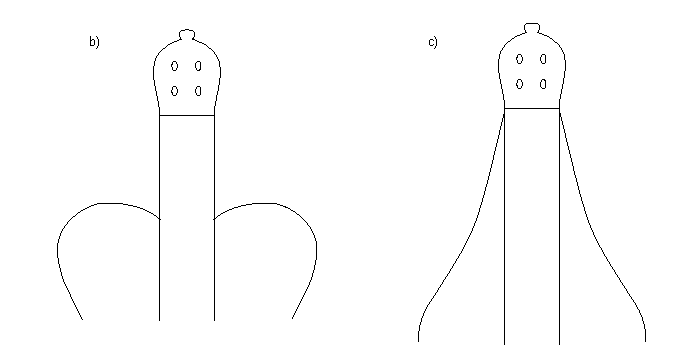
obscured by the keybox which extended over both parts. A third possibility is found on the small, often elegant guitar shaped hurdy-gurdies. On such instruments the impression of a neck jutting out from the body was avoided by tapering the body towards the peghead (c).
Similar to the construction of the peg-side, the shaping of the body outline of guitar or figure-eight shaped hurdy-gurdies was also subject to variety. As the representations show, medieval guitar shaped hurdy-gurdies were built with only slightly curved-in sides and ends which were rather equally curved to a greater degree (a).

The hurdy-gurdy kept this shape in France until recent times. In that country, as the pictures prove, it was produced also in the 17th century (ills. 65, 66) and not again until 1716, which is the year in which Henri Bâton first converted guitars to hurdy-gurdies (see page 159). The differences between the guitar shaped folk instruments of the 17th century (ill. 65) [figlink] and the hurdy-gurdies converted from guitars of the 18th century (ill. 67) [figlink] concern merely the type of ornamentation on the wheel and keybox covers and the shape of the peghead, which even in the 18th century was not uniform. The peghead ends either in a scroll (ills. 65, 68, 69, 70) [figlink] or in a carved head (ills. 67, 71, 72) [figlink] while on folk instruments it consisted of a square box (ills. 73, 74) [figlink]. Besides the shape of the peghead its attachment and connection with the keybox also varied. Often the keybox ended at the end to which the peghead was attached (ills. 65, 67, 71, 72) [figlink] or it was lengthened so that it jutted out a little bit from the end
and then connected with the peghead (ills. 69, 70) [figlink]. On instruments with small bodies the keybox was built so long that it connected with the peghead only at the end of a long neck (ill. 68) [figlink]. The length of this neck however never approached that of the body, as a hurdy-gurdy represented by Jean Baptiste do Laborde shows (ill. 75) [figlink]. In the explanation attached to this picture the author claims that this representation came from a 14th century manuscript, "ce qui prouve que la Vielle est fort ancienne" [fn][134-1].
With this comment de Laborde avoids not only the exact dating of the picture, but also leaves open the question as to whether it really originated from the same time as the manuscript, which is very doubtful, since the hurdy-gurdy player is surrounded by the peasant landscape so popular in 18th century French society. The instrument itself does not give us anything to determine its date on account of the inexactitude of its representation. The instrument in the picture has neither strings nor keys; only the wheel, two soundholes and two pegs can be recognized.
Aside from the manner in which the keybox and the peghead are connected, guitar shaped hurdy-gurdies are distinguished above all by the size of the body. Very large instruments, which attract attention especially because of the height of their sides (ills. 74, 76) [figlink], as well as extremely small hurdy-gurdies for ladies (ill. 77) [figlink] were built. The ladies however did not just play the instruments built especially for them, which mostly have a slightly varied form of the guitar type (see page 136 and ills. 88, 89, 90, 91) [figlink], but those of normal size as well. In contrast with the male hurdy-gurdy player (ills. 71, 72, 74) [figlink], they stood while playing and held their instruments low in front of them (ill. 69, 70) [figlink].
The guitar or figure-eight shaped hurdy-gurdies from other countries are essentially different in the form of the body compared with the French instruments. In Russia instruments were built which are noteworthy especially
because of their unusually low sides and extremely small wheels (ills. 63, 64, 78, 79) [figlink]. With their small flat bodies and f-holes in the lid these two- and three-stringed Russian hurdy-gurdies recall the forms of other bowed instruments. One of these is of even further interest on account of the unusual position of the keys (ill. 63) [figlink] (see page 128). Although hurdy-gurdies of this construction (a) were also played by blind beggars of White Russia (ill. 79) [figlink], they do not appear to have been made by folk musicians themselves, in contrast to the other guitar shaped hurdy-gurdies which in their form and construction are by far cruder (b).

These guitar or figure-eight shaped hurdy-gurdies with their extremely curved-in sides and wide ends appeared both in Russia as well as in Spain. On a Russian instrument of this type (ill. 80) [figlink] with two drone strings, one melody string and eleven keys the body is not only crudely constructed, but the tangents attached to the keys for shortening the strings are also unusually large; aside from producing the melody they also serve to prevent the keys from falling out (see page 117) the wheel in this instrument must be replacing an earlier one, since the wheels were, as other hurdy-gurdies show, always exactly fitted for their opening in the lid.
Instruments which come from Spain have the same form as this Russian hurdy-gurdy (ills. 81, 82, 83, 84) [figlink]. An important difference however lies in the number of strings which are shortened by the keys. In contrast to the Russian instrument (two drone strings, one melody string) the Spanish hurdy-gurdies were strung with four strings, of which three were shortened (ills. 81, 82, 83) [figlink].
With just one drone string the double strengthening of the melody tones through two additional strings is not to be assumed. It is more probable that at least one of the three strings was tuned to a different note, which would then, since all three were simultaneously and in the same place shortened, result in a piece of parallel music over one drone. In this case the tendency is to presume a tuning in the primary tone, its lower fifth (or fourth), and its lower octave, especially since all three instruments come from the vicinity of Santiago de Compostela. This was a city from which very early representations of European hurdy-gurdies have been handed down (ills. 17, 18) [figlink] probably with similar tuning. With the harmonies described above then this could be an ancient tradition which survived until recent times.
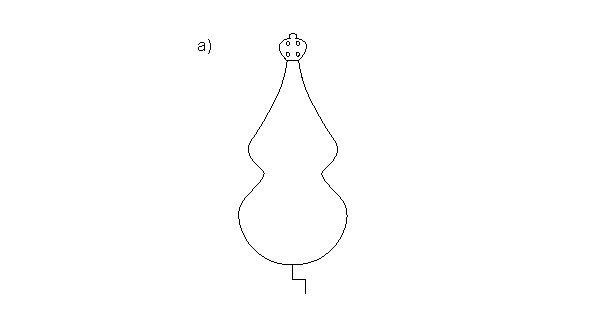
A variant of the guitar form is represented by those instruments whose bodies are tapered towards the peghead (a), a method of construction which was known in the 15th century, as the representation of an angel playing a hurdy-gurdy (ill. 85) [figlink] proves.
Such instruments were mostly built in 18th century France (ills. 86, 87) [figlink], where they were very popular, which was due to the fact that they were played at the French court, which set the standard in all questions of fashion and taste. While popular, their image was eclipsed by the hurdy-gurdies converted from or in imitation of guitars and lutes.
An especially elegantly decorated instrument (ill. 88) [figlink] belonged to the princess Adelaide (1732-1800) [fn][137-1], the daughter of Louis XV. This hurdy-gurdy is ornamented with inlaid precious stones and decorated with carved wood, and the wheel cover is carved and lined with velvet. It has two melody and three drone strings, of which one is a trompette string (see page 60) . More than two chromatic octaves are provided by 16 lower and 12 upper keys.
For an instrument that was played by a woman it was very large, since people liked to build hurdy-gurdies in this form small and elegant for ladies (ills. 89, 90) [figlink]. Despite being considerably shorter in length these instruments had the same number of keys as the large instruments, although only three or four strings. Small hurdy-gurdies of this type of construction were decorated with female porcelain figures, and in a few cases these figures were even succeeded by automata which could simulate the playing of a hurdy-gurdy (ill. 91) [figlink] [fn][137-2].
On the hurdy-gurdies in guitar form with a separate neck or peghead the curves of both ends were approximately equally wide (a). On the other hand, on instruments with the body tapering towards the top the upper curve was considerably narrower (b), so that the crank end of the instrument was emphasized on account of the greater width of the body there (ills. 88, 89) [figlink]. This reduction in the width of the body towards the top, which is observed in Germany on rather large hurdy-gurdies (ills. 92, 93) [figlink], and also on smaller and narrower hurdy-gurdies (ill. 94) [figlink], probably led to a form of instrument on which after the curve
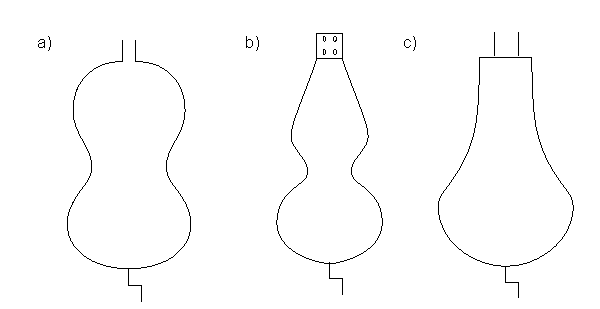
of the lower end it tapered gradually to the peghead, and therefore no longer
had an upper curved side (c) (ill. 95) [figlink].
From the guitar shape (a), probably from the tapered body (b) appears to have come yet another form of the hurdy-gurdy, which has a body with the shape of a stunted figure eight. On such instruments the upper and lower curves are no longer connected with a slightly curved in side, but a separated from each other by a sharp bend. From the upper curve the body then tapers gradually towards the peghead (d) or it is marked off from this part of the body. The top part of the body, on which part of the keybox lies, is sometimes so narrow that it almost looks as if the instrument has a neck (ill. 96) [figlink]. This method of construction could have contributed to the building of instruments of this form with a neck distinct from the body and on which practically the entire keybox was situated (f) as shown in photographs (ills. 97, 224) [figlink].

The spread of hurdy-gurdies of this shape remains essentially restricted to Germany, where they were built in the 17th (ills. 98, 99, 100) [figlink] and in the 18th centuries (ills. 96, 101, 103) [figlink]. Some of these instruments had three (ills. 96, 104) [figlink] or five strings (ill. 98, 99, 100, 101) [figlink]. The number of keys varies between 11 and 12, and the peghead on all instruments of this form are square-shaped, and this indicates a remarkable uniformity in the tonal range and in the manner of construction. The generally unchanged form, the consistantly diatonic tonal range, the small number of strings and the simple ornamentation indicate that these hurdy-gurdies were purely folk instruments which were not influenced by the other already improved instruments of this period. Passed on unchanged or build in the same manner as older instruments, they satisfied the requirements of village players.
In another group of 18th century hurdy-gurdies used in another geographical area the bodies also have the form of an eight with sides tapering towards the peghead, except that here an additional piece was added between the two end curves (a), giving the impression of a two-part body (ills. 106, 107, 108) [figlink]. These hurdy-gurdies have yet other characteristics which distinguish them from other 18th century instruments and which apparently represent regional peculiarities. One very large instrument (ill. 106) [figlink] is strung with six strings, of which two are of gut and four of metal. Just this stringing and its arrangement is unusual. For every gut string there
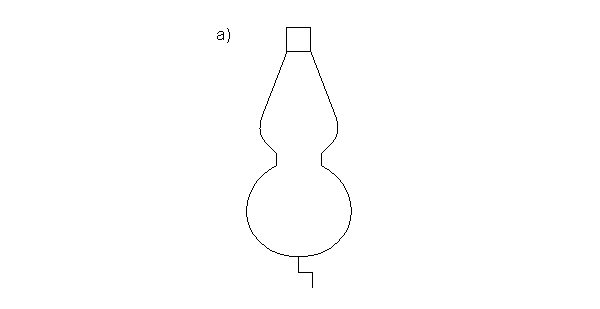
are two thin metal strings. All six strings are stretched through the keybox, but do not end as usual in a common tailpiece; rather separate bridges and tailpieces are provided for the strings which are divided into two groups of three. The tangents on the keys shorten only the gut strings, so that the metal strings must have served as high-pitched drone strings.
[partial text is missing]
[partial text is missing]
According to Georg Kinsky this instrument was built in the 18th century in Germany [fn][141-1]. The Flemish inscription on the shoulder band however indicates that it came from Flanders. There are though no other instruments of the same or similar construction known from either territory. This hurdy-gurdy however and two others from Bohemia, dated in the18th century (ills. 107, 108) [figlink] have a noticeably large number of similarities: all three instruments have the same form, as well as a lever for the removal of some of the strings. Two of these hurdy-gurdies show a similar arrangement of the keys (ills. 106, 108) [figlink], and on all three instruments the strings individually or grouped in pairs, go to separate tailpieces over individual similarly shaped round bridges. This practice is typical even today on Bohemian hurdy-gurdies (ill. 118) [figlink]. These peculiarities indicate such a close relationship between the Bohemian instruments and the supposedly German hurdy-gurdy that it seems justified to assume that this instrument was built in Bohemia.

Yet another instrument can be included in this group of Bohemian hurdy-gurdies (ill. 110) [figlink]; this one has two rows of keys with 6 upper and 12 lower keys equally arranged. In the photograph a removal lever and two of
the originally three round bridges which sit behind the wheel can also be seen. All of the strings run through the keybox and over the wheel to a single tailpiece. There are nine strings, which is an unusually high number. The instrument reportedly has two melody strings and seven drone strings. The tuning pegs however are arranged next to each other in three rows of three each. This is exactly the same arrangement as on the six-stringed instrument in illustration 106, where for every row of pegs there is one melody string and two drone strings. Therefore it can be assumed that the hurdy-gurdy pictured in illustration 110 has three melody strings with two drone strings each. On account of the very typical characteristics, it is likely that it comes from the same area as the other instruments.
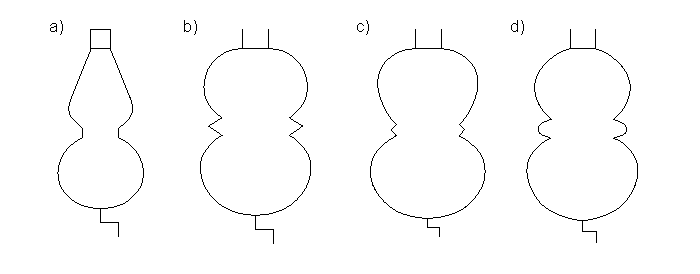
In comparison with these it exhibits a slight change in the shape of the body, in that instead of the intervening pieces in the sides (a) a slight bulge appears (b). This form is more similar than the others to the guitar shape and particularly to the very popular construction of two player instruments in the Middle Ages. In the shape and size of these bulges on medieval hurdy-gurdies there were great differences: they were as small (c) as the ones in illustration 110 (ills. 17,22, 23) [figlink], or also so large (d) that they looked like an additional part of the body (ills. 19, 20, 21) [figlink]. Later these bulges were no longer built and it is therefore not to be assumed that medieval patterns were consulted in the design
of the instrument under discussion. Rather it is tempting to conclude that the middle pieces which the other Bohemian pieces display (a) were arched here for decorative purposes.
Instruments whose common characteristic is the use of corner blocks also belong to the large group of hurdy-gurdies with guitar or figure-eight shapes. A predecessor of this type of instrument is found in the angel concert in the dome of Santa Maria die Miracle in Sarong, painted by Gardenia Ferrari in 1535 (ill. 111) [figlink]. Ferrari, who was not only a painter but a poet and musician as well, represented in his ensemble no fewer than 18 singers and 61 musicians with 40 different instruments [fn][143-1]. His hurdy-gurdy shows an amalgamation of elements from different sources: the heart-shaped peghead comes from the lira family, as do the sides which are curved in to the shape of a C and are provided with corner blocks. The rose was derived from the lute family. The body which runs to the very long neck, which has the keys, seems to belong to the viola de gamba family. Very probably there was no actually existing instrument which served as a model for this unique representation; the same can be assumed of 14 of the 56 instruments painted, which have to be considered as curiosities [fn][143-2].
Guitar shaped hurdy-gurdies with corner blocks were widespread in later times and were built in several countries. According to the country of origin variances in the form of these instruments can be established: the German (ills. 112, 113) [figlink], Austrian (ills. 114, 115) [figlink], Hungarian (ills. 115, 117) [figlink] and Moravian hurdy-gurdies (ill. 109) [figlink] have not only sides curved in to various degrees (a, b), but also some have three-cornered corner blocks (ills. 109, 112, 114) [figlink], and some have four-edged corner blocks (ills. 113, 115, 117) [figlink] (c, d).
As Austrian (ill. 119) [figlink] and Hungarian (ills. 120, 121, 122) [figlink] pictures of hurdy-gurdy players show, the guitar shaped
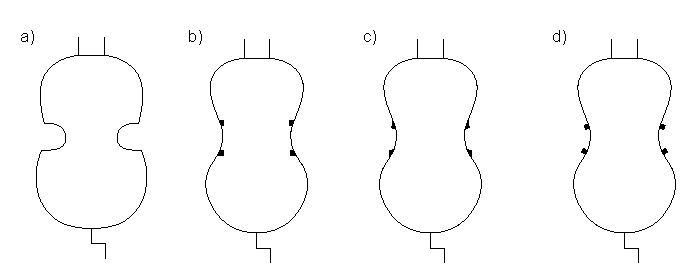
instruments with corner blocks from these areas were very large. The player in illustration 121 is Bela Bartok. Despite the lack of ornamentation a hurdy-gurdy appearing to be more refined that these comes probably from Piedmont (ill. 123) [figlink]. [fn][144-1] It belonged to the estate of the Empress Maria Anna (1803-1884) [fn][144-2]. On the cover of the keybox stands the signature "L.G. 1797", and the question is raised as to whether an instrument in the Stockholm Museum (ill. 124) [figlink] with the signature "L.G! 1743" was built in the same workshop or by the same maker, since both instruments apart from this peculiarity also have shape, ornamentation , and number of keys (11) in common. Only the number of strings is different.
A characteristic expression of this form of hurdy-gurdy is found in Eastern Europe. There hurdy-gurdies were built whose bodies display such great similarity with those of other bowed instruments that the supposition can hardly be suppressed that these instruments were originally converted into hurdy-gurdies from other instruments (ill. 125) [figlink]. Two instruments in particular support this supposition; on these it can be clearly seen that they were only later converted to hurdy-gurdies (ills. 64, 126) [figlink]: on the lid of one instrument the f-holes of the bowed instrument can still be seen underneath the keybox (ill. 126) [figlink], while on the
second hurdy-gurdy the wheel shaft is situated on the lid and not under it and from the crank over a special support through the wheel to the keybox, whereby behind the wheel it runs through the bridge which is fastened there for the melody string (ill. 64) [figlink]. This was, on account of the wheel shaft, strengthened by a projection which extended parallel to the wheel across the soundboard all the way to the sides. Likewise the keybox which was also added later and which is supported on the wheel side by a cross-piece extending from one corner block to the other across the lit. The piece partly covers the f-holes. which were previously there. All of these details as well as the unusual position of the keys of the instrument in illustration 62 (see page 129) prove that the body of another bowed instrument, probably a viola, was here used to build a hurdy-gurdy.
In Russia this form of body was also given to modern hurdy-gurdies which had been further developed, as that belonging to J.M. Skljaro (ill. 127) [figlink][fn][145-1], as well as to newly built folk instruments. Although these have corner blocks, they are clearly different from the converted former bowed instruments (a). Hurdy-gurdies were made with rather low sides and only slightly curved-in sides (b) (ill. 128) [figlink], and curvatures (c) (ills. 129, 130) [figlink], a type of construction which was also used in Romania (ill. 131) [figlink].
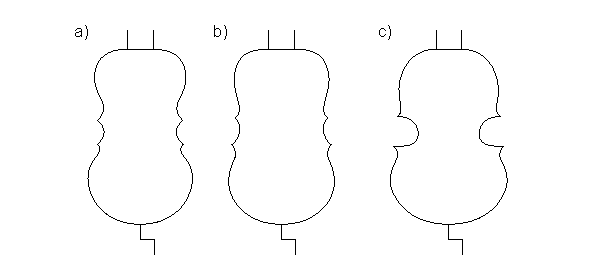
The Russian hurdy-gurdies (ills. 132, 133) [figlink] are considerably smaller in comparison with the Austrian and Hungarian instruments of the same form (ills. 119, 120, 121) [figlink]. The uniformity in their shape and size, their small number of keys and the limited ornamentation indicate that these hurdy-gurdies are folk instruments. The guitar shaped hurdy-gurdies with corner blocks of other countries had the same function as well, and these likewise are scarcely ornamented at all and have only a small number of keys.
The guitar or figure-eight form with its different characteristic, mostly regional, variations was already used in the Middle Ages and can be considered to be the most widespread shape of the hurdy-gurdy's body. It was used throughout all Europe and remained the principal shape in which the hurdy-gurdy was built until recent times in many countries.
B. Hurdy-gurdies With Two- or Three-Part Crank Ends
The body shapes just discussed have a fairly obvious derivation from the guitar
or figure-eight shape. In contrast to these are other shapes which, have in
later times been so changed that their origin often is no longer recognizable,
while they also descend from the guitar shape originally. The change in such
instruments affects first the end on which the wheel shaft emerged from the
body. At first this shaft sat at the highest point of a curve (a), which then
on other guitar shaped hurdy-gurdies (ills. 80, 130, 131) [figlink] frequently
became quite flat (b). In this shape then an inward curvature was made (c)
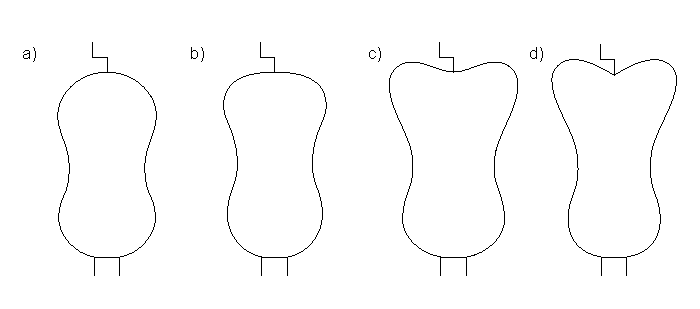
which was then so extremely formed that a division into two parts of the crank end resulted (d) and the shaft emerged from the bend that was formed or from a special piece situated there (ills. 134, 135) [figlink].
Hurdy-gurdies with the crank end divided into two parts were known already in the late Middle Ages (ill. 135) [figlink]. According to representations of only partially visible instruments it can be suspected that this type of construction was applied to instruments both with and without necks. In the 'Ascension of Mary", begun by Stefano di Giovanni (called Saddetta) and finished by another Siennese master, the top half of a hurdy-gurdy body which is tapered towards the peghead is visible (ill. 137) [figlink]. This hurdy-gurdy must have a neck, since it is only held so high in front of the body so that the angel playing it can reach the keys sitting on a neck. On the other hand the only partially visible instrument of a shepherd in the "Adoration of the Shepherds" by Jan de Beer (c. 1475-before 1536) does not have a neck (ill. 138) [figlink]. Here the player is not holding his instrument in front of him, but has it hanging on one side. A hurdy-gurdy held in such a position cannot have a neck, since the keys which would be sitting on it could not have been reached by the player's hand. The assumption that this instrument had a keybox on its soundboard is supported by the representation of a hurdy-gurdy on the grave of Sebaldus in Nürnberg by Peter Vischer from the first quarter of the 16th century, which has the same form and a keybox (ill. 136) [figlink].
The outlines of hurdy-gurdies with crank ends divided into two were frequently changed so much that of the original guitar shape (a) sometimes only the split arch of the crank end remained. Instruments were built whose bodies around the position of the wheel still had a curve, but whose sides were no longer curved in, but allowed to run straight to the peghead (b) (ill. 139) [figlink]. Next to almost square shaped hurdy-gurdies (c) (ills. 140, 141) [figlink] instruments were built whose sides tapered greatly towards the peghead (d), so that these hurdy-gurdies had practically the shape of a heart, as that of a
figure (c. 1510) on the portal of the church of Saint-Nicolas-du-Pont in Toul (ill. 142) [figlink] and that in a 17th century painting by David Teniers (ill. 143) [figlink]. With other shapes the sides also taper towards the peghead, but then widens into a neck upon which part of the keybox sits (e).
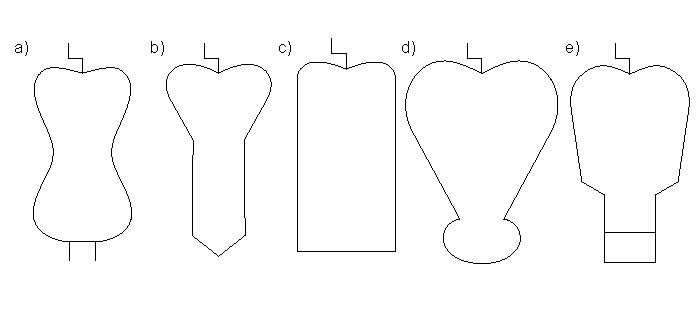
Instruments of this type of construction, as the reconstruction of an old hurdy-gurdy in the musical instrument museum in Brussels (ill. 144) [figlink] and a preserved 16th century instrument (ill. 145) [figlink], have a lesser tonal range. Both hurdy-gurdies have only eleven keys and are simply executed, which would indicate a countryside origin. This is especially clear on the instrument in illustration 145, whose bridges behind the wheel show a shepherd and an animal. A similar figured shaping of the bridges is displayed by another German folk instrument (ill. 146) [figlink], which does not have the split crank end, but otherwise has the same shape.
An extremely interesting instrument with a split crank end is in the possession of the Germanische Nationalmuseum in Nürnberg (ill. 147) [figlink]. This hurdy-gurdy is very difficult to date, because some details were obviously added later. Unusually expressive carvings decorate the tailpiece with a representation of Christ crucified, and on the keybox cover where the middle of the three fields shows the holy family. However the wheel cover, the peghead and the pegs are completely undecorated. Usually when
a hurdy-gurdy was ornamented with paintings, carving or inlay, this decoration was placed everywhere possible, and hence also on the pegs and on the wheel cover. Therefore it can be concluded that on this hurdy-gurdy either the carvings on the keybox and on the tailpiece, or else the pegs, peghead and wheel cover are later additions. The same thing holds for the keys which are now in the instrument. All the preserved instruments have key openings just big enough so that they fit in exactly. which are much too thin to fill the openings made in the side of the keybox; The extra layer on both sides of the keybox by the wheel and the carved sun and moon ornaments on the lid appear to be later additions as well. The ornaments occupy places which were originally once partly covered by supports of some kind, as is apparent from the wood and above all from the round holes in the lid, which no longer have any function.
The extreme width [fn][149-1], even in comparison with a rustic folk instrument, and all of the details mentioned above lead to the conclusions that the body of a different instrument was utilized during the construction of this hurdy-gurdy. Since however no other string instruments of this form are known, it must be assumed that this instrument was also originally built as a hurdy-gurdy which was changed in the course of time, perhaps several times.
In the attempt to determine the date of this hurdy-gurdy the ornaments cannot be used, since they appear to have been added later. The only part which can be used for this purpose is the shape of the body, which on the basis of hurdy-gurdy representations (ills. 140-145) [figlink] can be traced to the time from the 15th to 17th
centuries, which have led some researchers to put the date of this instrument in the 16th century [fn][150-1].
The pertinent period cannot however be so closely defined, but must be extended to the 17th century as well.
Besides the hurdy-gurdies with the type of split crank end as characterized above (a) in the same period there were also instruments whose wheel shaft emerged from a flattened inward curve (b) (ill. 148) [figlink], which however otherwise have the same shape. The bodies which at first still recalled the guitar-shaped hurdy-gurdies were tapered in the same way towards the peghead (ill. 59, 149) [figlink] or widened into a narrow neck (ill. 150) [figlink].

The inward curvature of the crank end apparently hampered the course of the wheel shaft after it entered the body, which led to a method of construction in which an extra piece was situated in the curve (c), through which the shaft passed on its way into the actual body (ills. 54, 55, 56, 57) [figlink]. Next to this shaping of the crank end arose another method of construction related to it, which consisted in a double split of the crank end (d). This form can most likely also be traced back to the guitar shaped hurdy-gurdy, which the representation of a hurdy-gurdy from the first half of the 16th century clearly shows (e) (ill. 151) [figlink] though it is admittedly fantastically designed. The instrument of the lady pictured here, one of the nine muses in
a tapestry [fn][151-1] has ornamented sweeping curves top and bottom, but the body sides are no longer curved in, but run almost parallel to one another.
On the basis of numerous preserved representations of instruments with a double split crank end it can be show that despite the division of the crank end into three parts which is common to them all, this feature as well as the rest of the body shape was constructed in various ways. On some instruments the three bulges on the crank end were connected by flat (ills. 60, 152) [figlink] or deep (ills. 153, 154, 158, 159) [figlink] curves (a). However most of these hurdy-gurdies show two sharp divisions of the three bulges (b), whereby it appears as though the crank end has been divided into exactly three parts (ills. 62, 155-157, 160-164, 166) [figlink]. On some instruments this threefold division is yet again interrupted by another slight curve inwards on the middle curve (c) (ills. 167, 168) [figlink].
The central bulge, from which the wheel shaft emerges, was shaped in three different ways: its curve was slighter than that of the exterior curves (d) (ills. 60, 166,) [figlink]; all three bulges had the same height (e) (ills. 158, 163, 167, 168) [figlink]; or the central bulge was higher than those on the outside (f), which is the case with most of the instruments (ills. 62, 152-57,159-162, 164, 170) [figlink].
Aside from these methods, differing one from another, of shaping the crank end, differences in the shape of the rest of the body can also be established. Next to a few instruments whose bodies taper towards the peghead from a wide curve on the crank end over a curved-in side (g) (ills. 60, 153, 156) [figlink], there were a few hurdy-gurdies whose sides in distinction from the width of the crank end followed an almost parallel course (h) (ills. 62, 154, 157, 161-164) [figlink], however on most of the instruments the sides were more or less greatly tapered towards the peghead (i) (ills. 152, 158, 159, 160, 166, 167, 168) [figlink].
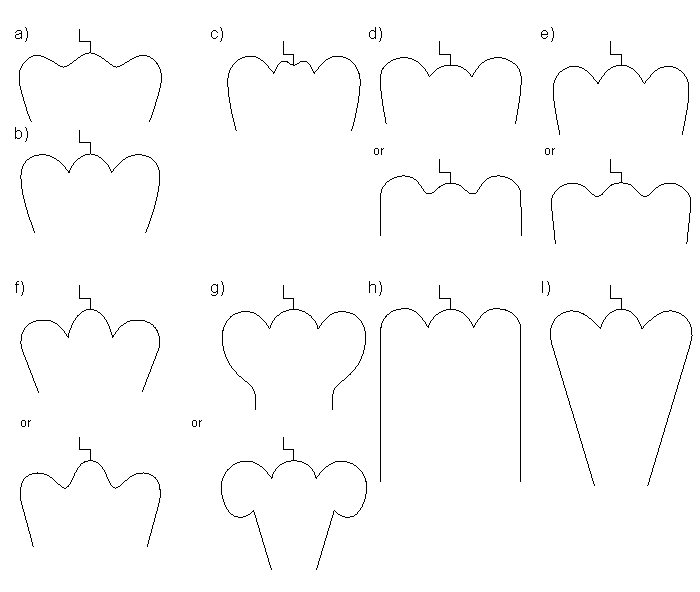
As is evident from the representations, during the period of the 16th through the 18th centuries such hurdy-gurdies were found mostly in the hands of folk musicians (ill. 154) [figlink], traveling musicians (ills. 152, 153, 158, 159) [figlink], and beggars who were usually blind (ills. 160, 161, 163, 166, 168, 170) [figlink] [fn][152-1]. The fact that they were used almost exclusively by traveling musicians and beggars explains why, in contrast to instruments with other forms from this period, only one single hurdy-gurdy of
this type was preserved (ill. 155) [figlink]. Its crank end has three bulges, the rest of the body however is distinguished in its form for those of the other instruments represented.
Almost all of the represented instruments of this form show ornamentation, and the soundholes in the outside bulges of the crank end can be considered to be a characteristic common to them. These are often replaced by roses which are carved into the soundboard in the same place, but which represent ornaments only and no longer have a function as soundholes. All the instruments have one row of keys; just one hurdy-gurdy in the hands of a blind musician in a painting by Georges de la Tour (1593-1653) (ill. 163) [figlink] seems to possess two rows of keys one over the other which means that chromatic sequences were possible on this instrument. This picture is especially important for another reason: the wheel cover of the instrument is missing and therefore for the first time it can be seen that cotton or wool was wrapped around the strings where they lay upon the wheel, a procedure which serves to soften the sharp sound of the hurdy-gurdy even today. As this painting proves, it was not first used in the 18th century during the hurdy-gurdy fad in France, but was already employed in the 17th century. Probably it is an even older practice which just has not been able to be proven to be older.
From instruments with a three-part crank end, whose bulges were connected with inward curves (a) came probably a form of the hurdy-gurdy on which the central bulge for the crank was especially emphasized while the end bulges were removed (b). These hurdy-gurdies were built from the 16th to the 18th centuries, however there have been only a few representations of such instruments preserved (ills. 171, 172, 173) [figlink].

Closely related to this form of hurdy-gurdy is a form of the instrument which
was built only in France from the 16th to 18th centuries, on which the crank
end has a slight central bulge and points which are bent slightly upwards in
place of the exterior curves (c). Through this manner of construction the roses,
which were also on these instruments, were repositioned further up on the soundboard
and closer to the wheel. The bodies of these hurdy-gurdies were usually considerably
smaller and thinner than those of other instruments with a similar shape. Their
sides either gradually tapered towards the peghead (d) (ills. 174, 175) [figlink]
or received again a small bulge before merging in to the body proper (e) (ills.
176, 177, 178, 179, 180, 181) [figlink]. When the soundboard was overburdened
by the weight of a keybox which lay partly upon it and by the peghead which
was attached to it, supporting braces (f) had to connect the
peghead and the body to prevent the soundboard from splitting (ills. 176, 177,
178, 179) [figlink].

Such braces were already used in the late Middle Ages on similarly constructed instruments (ill. 62) [figlink]. This device was not necessary when the body remained wider than the keybox right up to the peghead (ills. 175, 180, 181) [figlink].
Hurdy-gurdies of the form described above (d, e, f) from the 16th and 17th centuries, of which some
have been preserved, are almost entirely instruments which were in the possession of the well-to-do, which is indicated by the tonal range which was considerably greater than that of the folk instruments, and the exquisite workmanship: carving, paintings, and inlaid precious stones.
A famous instrument of this type is a hurdy-gurdy from the French court , which is now in the possession of the Victoria and Albert Museum in London (ill. 178) [figlink]. The soundboard of the instrument was decorated with hunting scenes and the monogram of Catherine de Medici, and a 'H' with a crown is found on the wheel cover. The instrument probably belonged to Henry III of France (born 1551, ruled 1574-1589), whose father Henry II (born1518, ruled 1547-1559) was married to Catherine de Medici (1519-1589). This 16th century instrument is already provided with two key rows, whose extreme ends are even distinguished by color. The lower row has 13 keys, and the upper row has 10 keys. Whether this is the original number of keys however is a question which must remain open. In the 18th century the instrument belonged to the lute-maker Hurel in Paris, who sold it to Mademoiselle de Mesmon, the sister of the royal stable master Chevalier de Mesmon. Hurel characterized the instrument as belonging formerly to Henry IV, but Antoine Terrasson objected on the grounds that if this were the case then the coat-of-arms of Navarre should also have been represented, and not just that of France. Besides one of the two chains of orders which frame the French coat-of-arms is that of the Order of the Holy Spirit, founded by Henry III in 1579 [fn][155-1]. The Chevalier de Mesmon gave the instrument to the lute-maker Bâton l'Aine of Versailles for inspection and repair. As Terrasson reports, Bâton's work consisted mainly in putting new keys in the old key holes [fn][155-2]. The supposition however cannot be dismissed that Bâton did not only use the old key holes, but extended the tonal range as well and brought it up to the standard of his day, for the number of keys of this instrument
corresponds to those of 18th century French instruments. It can however be more likely that this instrument originally had such a great tonal range, since other instruments which likewise come from the 16th century and have the same form have an even greater number of keys, as for example that pictured in illustration 179, which has 26 keys (15 lower, 11 upper). This hurdy-gurdy has seven (normally six) strings, the same number as the instrument in illustration 180, represented in the 18th century. Of these seven strings four serve as drones, while three are shortened by the keys. One of the three Chanterelles was originally a 'voix humaine' [fn][156-1] and had the same function as the 'vox humana' of the organ [fn][156-2], which had a nasal metallic sound except in the middle range [fn][156-3] and was mostly used with tremolo and swell [fn][156-4]. Accordingly the 'voix humaine' of the hurdy-gurdy, which was considerably thicker than the other melody strings, was also to give the Melody a lively tremolo effect; instead rather it gave, like the 'vox humana' of the organ, a sharp quality to the tone of the instrument. Close up it was unbearable and was usually not used at all, but was removed [fn][156-5].
As representations show (ills. 174, 175, 176, 181) [figlink], hurdy-gurdies with the form described above were used also in the 18th century, as well as the newly introduced "vielles en guitare" and "vielles en luth". The peasant fashion of the 18th century French aristocracy, in the following of which the bagpipes and the hurdy-gurdy again became socially respectable, brought the still surviving instruments of the 16th and 17th centuries to prominence again.
C. Uncommon Shapes
In the Middle Ages most of the hurdy-gurdies being built were made in the guitar shape. Here and there representations of hurdy-gurdies with small bodies can be found, mostly with wide crank ends and straight sides tapering towards the neck (ills. 4, 6, 8, 9) [figlink]. On some instruments the back seems to be arched (ills. 7, 10) [figlink] as later on hurdy-gurdies in lute form, which the instrument from Istria (ill. 7) [figlink] especially recalls. The exception is an 18th century representation of a hurdy-gurdy (ill. 182) [figlink] whose body sides are straight with only slight upper and lower curves and which is similar to the medieval instrument of illustration 4, but for the most part these uncommon forms can later no longer be found.
On the other hand other instruments which recall the box hurdy-gurdy already discussed (see page 100, page 105 and ills. 27-42) [figlink] come from the 17th and 18th centuries. Their crank ends are quite straight as on the box form which was built until the 18th century (a), the parallel sides however are tapered shortly before the neck (b) or the peghead (c) (ills. 61, 183, 184) [figlink].
The hurdy-gurdy in another 18th century representation (ill. 185) [figlink] also has a straight crank end, but its shape probably arose out of the guitar shape, although it does not have the curves characteristic of this shape. The body, which is wide at its lower end, narrows in the middle and then widens again in the vicinity of the peghead (d).
[diagrams a-d]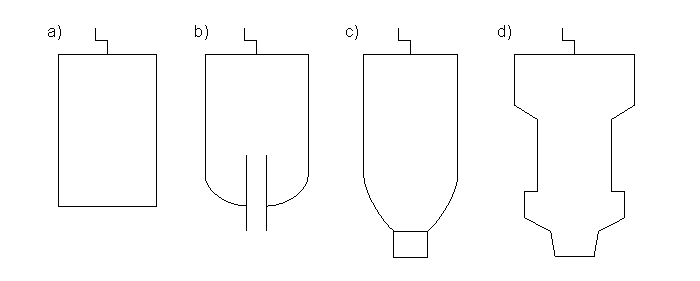
Two more 18th century representations (ill. 186, 187) [figlink] must be mentioned here. The common characteristic of these instruments is the body which is very narrow in the area of the keybox. Although the body was at this point constructed wider than the keybox, the impression of a neck is given, and this is strengthened by the fact that the keybox lies almost entirely on this part. This manner of construction can be traced to the guitar shape, whose lower curve was maintained, the upper curve however replaced by a neck. The one instrument has an almost circular body with sides tapering to a neck (a); the other still displays the corner blocks of the lower curve (b), behind which the sides get gradually narrower towards the neck.
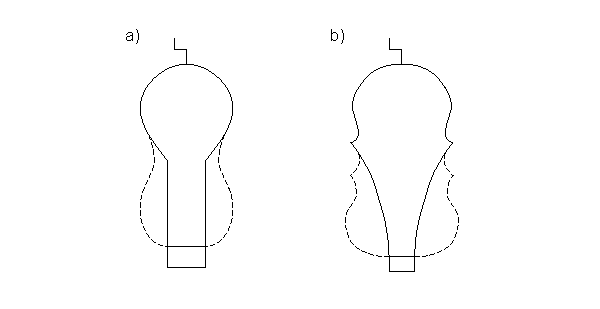
Both of these hurdy-gurdies come from the 18th century. One comes from Bohemia (ill. 186) [figlink] , the other from Slovakia (ill. 187) [figlink]. They show a certain relationship to the representation of a hurdy-gurdy from Flanders (ill. 188) [figlink] as well as to two pictures of Saxon peasant women playing the hurdy-gurdy (ills. 189, 190) [figlink], whose instruments have a three part crank end.
D. The "Vielle en luth"
When the hurdy-gurdy became a fashionable instrument in French courtly society almost overnight at the beginning of the 18th century, the new fad provided the instrument makers in Paris with a deluge of orders which could not be filled as fast as wished. Because the
aristocracy had up until then preferred harpsichords, lutes, guitars, and theorbos, they had no hurdy-gurdies in stock. The first hurdy-gurdies with which the society in that time became acquainted with were the rather crudely built, loud and sharp sounding instruments of the folk musicians. After the nobility found pleasure in the hurdy-gurdy the instrument makers in the capital strived to find ways to provide the instrument with a more flattering exterior and to improve the tone. The first to attempt to perfect the hurdy-gurdy was the lute-maker Henri Bâton of Versailles. His guitars, which after the change in fashion became 'shop-sitters', led him in 1715 to the idea of simply converting these to hurdy-gurdies, and he had great success with his "vielles en guitare". The sound of these hurdy-gurdies was loud, although softer than that of the old folk instruments [fn][159-1]. [Editor's note: the date given in the source listed is 1716.] As Bâton discovered a little later, the sound was even softer when the bodies of lutes and theorbos were converted into hurdy-gurdies. He produced this completely new form of "vielle en luth" for the first time in 1720 and attained an even greater success with these instruments than with the guitar hurdy-gurdies. Bâton not only gave the hurdy-gurdy a new shape, but was the first of many to attempt to extend the tonal range of the instrument (see page 123)
The characteristics common and unchanging for all hurdy-gurdies of the lute shape are the belly constructed from nine strips of wood, the two C-sound holes on the crank end of the instrument and a carved peghead, which ended in a sculptured miniature head of a woman or a man. The shaping of these heads into musketeers, Turks, women, angels, Moors, or even crowned heads was executed with great care in the 18th century and entrusted to artists such as Pineau or Lafille. [fn][159-2].
Like the size of the instruments (ills. 191, 199, 200) [figlink] the ornamentations above all were varied, with which the cover of the keybox, the wheel cover and the tailpiece were decorated. Next to hurdy-gurdies richly decorated with jewels, ivory, or rare woods (ill. 192) [figlink] or with more simple
ornamentation (ill. 193) [figlink], there were in the 18th century all those whose ornamentation consisted of narrow inlaid pieces of wood which formed a border all around the sides of the keybox and the wheel cover as well as the tailpiece (ill. 194) [figlink].
The use of lute bodies in the construction of hurdy-gurdies in the 18th century forms a break in the development of hurdy-gurdy shapes: their changes had been up until this time relatively slight and did not lead to any essentially new forms in modern times; however with the lute body hurdy-gurdies without parallel sides appeared for the first time.
Although other forms were built, the "vielle en luth" became the principal form of the instrument in France, as a picture of a lute-maker's workshop in the 18th century "Great Encyclopedia" testifies with the lute hurdy-gurdy put in the foreground in a prominent position (ill. 195) [figlink]. This form was so successful that it was maintained on the French hurdy-gurdies built after the fad died out. It was very popular with the folk musicians in the 19th century (ill. 196, 197) [figlink] and is still built today in the French provinces.
One of the reasons why the lute form was so successful even in the French provinces and for such a long period was certainly because this shape was connected with a brilliant past. The main reason for the later constructions was however that the hurdy-gurdies with this form of body produced the most beautiful sounds.
In the 19th century extensive paintings, especially on the soundboard (ill.
198) [figlink], replaced the valuable ornamentation of the 18th century society
instruments. Contemporary hurdy-gurdies usually have little or no decoration
except the colors of the key ends and the black-and-white binding; however the
shape of the lute hurdy-gurdy's body has remained practically unchanged up to
the present.
1) J.B. de Laborde, Essai sur la musique ancienne et moderne, 4 volumes, Paris 1780, I 305.
1) G. Chouquet, Le Musée du Conservatoire National de musique, Cataloge déscriptif et raisonné, 2nd Edition, Volume I, Paris 1884, 49 No. 207.
2) E. Maingot, Les automates, Paris (1959), photo from the title page
1) G. Kinsky, Kleiner Katalog der Sammlung alter Musikinstrumente. Musikhistorisches Museum von Wilhelm Heyer in Cöln, Cologne 1913, 58 No. 342.
1) G. Skjerne (Hg.), Carl Claudius' Samling af gamle musikinstrumenter, Copenhagen 1931, 260.
1) K. Geiringer, Gaudenzio Ferraris Engelkonzert im Dome von Saronno, in: Beethoven-Zentenarfeier 1927, Internationaler Musikhistorischer Kongreß, Vienna 1927, 378-381.
2) K. Geiringer, Gaudenzio Ferraris Engelkonzert, 379.
1) J. Schlosser, Die Sammling alter Musikinstrumente. Beschreibendes Verzeichnis. Publication from the collections of sculpture, arts and crafts of the historic art museum in Vienna, Volume III, Vienna 1920, 72.
2) Maria Anna was princess of Sardinia, and her husband was Emperor Ferdinand I. Piedmont belonged to the kingdom of Sardinia since 1720, became French in 1802, and was returned to Sardinia in 1814.
1) K. Vertkov, Atlas der Volksmusikinstrumente der UdSSR, 43.
1) The dimensions compared with the large hurdy-gurdies in ills. 99 and 100 [figlink]: length 71 cm (70.5 cm amd 69 cm), maximum width 53 cm (!) (30 cm and 30 cm). Extension at the peghead end 6.5 cm (8.0 cm and 5.5 cm). Extension at the crank end 13.5 cm (12 cm and 10 cm).
1) G. Kinsky, Geschichte der Musik in Bildern, Leipzig 1929, 147. Abb. 1; T. Norlind, Geschichte des Klaviers. Systematik der Saiteninstrumente II, Stockholm 1939, 17; A. Ott, 1000 Jahre Musikleben, Munich (1961), Abb. 34.
1) J.H. von Hefner-Alteneck, Trachten, Kunstwerke und Geräthschaften vom frühen Mittelalter bis Ende des 18. Jahrhunderts. From simultaneous originals, 2nd edition, Volume 8, Frankfurt 1887, 11.
1) The image of a Tyrolean street singer in an 18th cent. Psalter from South Tyrol. (ill. 164) [figlink] found by Emmanuel Winternitz (E. Winternitz, Bagpipes and Hurdy-gurdies, 83 Fig 41.) did not emerge at this time and in this region, but is probably a copy of an illustration by Jacques Callot (1592-1635) (ill. 165). [figlink]
1) A. Terrasson, Dissertation sur la Vielle, 229ff.
2) A. Terrasson, Dissertation sur la Vielle, 234f.
1) G. Chouquet, Le Musée du Conservatoire National de musique, Cataloge déscriptif et raisonné, I 49.
2) A. Terrasson, Dissertation sur la Vielle, 248.
3) C. Locher, Die Orgelregister und ihre Klangfarben, 4th Edition, Berlin 1912, 158.
4) P. Smets, Die Orgelregister. Ihr Klang und Gebrauch, Mainz 1958, 293. The vox humana "must stand unconditionally in the swelling and connected with a dully pronounced drone in addition to a slowly floating tremolo" (ibid, 293)
5) A. Terrasson, Dissertation sur la Vielle, 248.
1) A. Terrasson, Dissertation sur la Vielle, 249f.
2) E. de Bricqueville, Notice sur la vielle, 21.
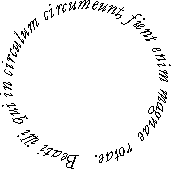 Please
contact us if you have comments or questions about
this page or other pages on this site.
Please
contact us if you have comments or questions about
this page or other pages on this site.
Alden and Cali Hackmann
Olympic Musical Instruments
© Original text in German copyright 1977, Verlag für systematische
Musikwissenschaft GmbH
© Translation copyright 2005, Olympic Musical Instruments
and the Bröcker Tranlation Group